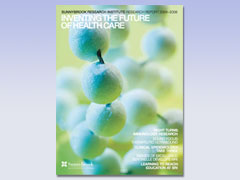Reigning in the Radical
Dr. Laurence Klotz, chief of urology at Toronto Sunnybrook Regional Cancer Centre (TSRCC) and an associate scientist at Sunnybrook Research Institute (SRI), thinks too many men with prostate cancer are treated more aggressively than the condition of their disease warrants. Indeed, statistics indicate that 93% of so-called favourable-risk patients in the United States in 2003 were treated radically with major surgery to remove the prostate gland and some surrounding tissue. "That's bad," says Klotz. "A radical prostectomy is a serious operation. It can have an impact on a patient's erectile and voiding function."
He's leading the charge to do something about it as the principal investigator of an international clinical trial that will seek to underline the benefits of a treatment strategy known as active surveillance.
This trial, which launched in September 2006 and has participants from Canada, the United States, the United Kingdom, the rest of Europe, Australia and New Zealand, will randomize patients with indolent, or slow-to-progress, prostate cancer in an effort to identify the extent of treatment needed. Of the one in six men who are diagnosed with prostate cancer every year, 40% may be candidates for this treatment. "That's a big deal," says Klotz. "We hope to demonstrate that you can reduce the impact of therapy with favourable-risk patients with this approach."
Conventionally, prostate-specific antigens (PSAs) are identified in blood tests used to diagnose prostate cancer early and to monitor the disease after treatment is delivered. "But we're using the rate of rise of PSA to determine whether a patient should be treated," says Klotz. "This is a novel use."
With active surveillance, doctors treat patients individually, limiting their therapy to just the 20% whose PSAs are on the rapid rise, or whose stage of cancer, on repeat biopsy, worsens. Favourable-risk patients who qualify for active surveillance are those who have PSA counts lower than 10, Gleason scores of six or less, and who are considered to have "low-stage cancer."
Of the 500 people in Sunnybrook's program, fewer than 1% have died of prostate cancer in the almost 10 years since they have joined it. And of the patients who did die of prostate cancer, all of them have died so rapidly, says Klotz, that they were clearly not curable at the time of diagnosis. "So far, we don't have one patient who's had a prostate cancer death that, in retrospect, we believe was preventable."
Under the direction of Klotz, who is the leader of the GU site group at TSRCC, Sunnybrook has been using this novel strategy for almost 10 years in its treatment of prostate cancer patients. And the concept is catching on. "It started as a radical idea, this thought that you don't treat cancer," says Klotz. "But now it's being widely adopted."
The trial will involve 2,100 patients who will be accrued over the next five years and followed-up for 15 years after that. The organizing committee features one representative from each of six cooperative clinical trials groups (one each in Canada, the United Kingdom and Europe, and three groups in the United States). "The fact that we've been able to cobble together this consortium for a fairly complicated and expensive international trial is phenomenal," says Klotz.
Each country's group will finance its role in the study. In Canada, the research is being funded by the National Cancer Institute of Canada Clinical Trials Group.
"To be able to lead an initiative of this size is something you don't get to do too often," Klotz enthuses. "And to start with an idea that came out of a group 10 years ago and now has...moved to the stage of an international clinic trial; well, that is just the chance of a lifetime."
PDF / View full media release »





